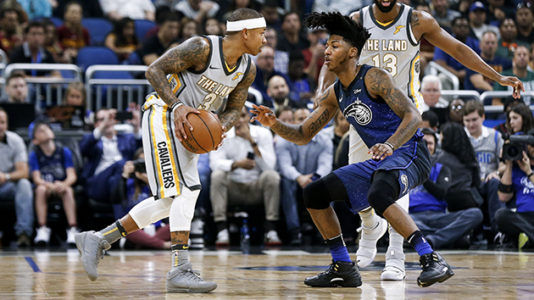Don Juan Moore/Getty ImagesBY: Chris Herring and Dimitrije Ćurčić
(NEW YORK) — Of all the shocking NBA free-agency moves this summer, Isaiah Thomas’s deal with Denver — for just one year, at the minimum salary for a veteran player — might have been the most telling, in terms of where the league is heading.
This time last year, Thomas — one of the NBA’s most underpaid players even then, at just over $6 million — was saying openly that the Celtics “know they’ve got to bring the Brink’s truck out,” a reference to the nine-figure max contract he felt he deserved. And on some level, it would have been difficult to argue with him. At 28 years old, the diminutive point guard was coming off a banner season in which he finished fifth in MVP voting while averaging almost 29 points per game (on one of the league’s best true shooting percentages) and led the Celtics to the East’s best record.
It’s no secret that much of the market collapse for Thomas’s services stemmed from questions about the torn labrum in his hip, which cost him months of rehab time before he ever suited up for the Cavs, then required surgery in March (while he was playing for the Lakers). But it also appears that the ever-changing NBA flipped its script entirely just before Thomas could cash in on a deal that scorers of his caliber generally get. The about-face highlights the fear teams have about committing big money to someone as short as Thomas, given the challenges his height creates in yet another league where an increasing number of players are roughly the same size.
Point guards and centers were closer in height last year than they’ve ever been, separated by an average of just 8.3 inches — down 21 percent from the 10.5 inches or so that stood between them during the mid-to-late 1990s, according to data from Basketball-Reference.com.
Basketball-Reference.com
Those shifts affect Thomas in two meaningful ways. First, the Tacoma, Washington, native — who, at just 5-foot-9, is the shortest player in the NBA — isn’t even close to the average size for a point guard of 6 feet, 2.5 inches. Which brings up the second issue: As such an outlier, the undersized Thomas becomes an even bigger liability on defense when his team is forced to switch on screens at that end of the floor — something that’s become far more common in the past five years alone. The median number of switches leaguewide has more than doubled over that span, from 4.3 per 100 possessions in 2013-14 to 9.1 switches per 100 possessions this past season, according to Second Spectrum.
“To even have a chance against a team like Golden State, you have to make a point of not being put into rotations,” Rockets coach Mike D’Antoni told me in May. “They’ll kill you that way.”
Certain teams are better equipped to play that kind of defense than others — the Rockets and Warriors, widely considered the league’s best teams, led the NBA in switch frequency — but the process doesn’t always work as well when Thomas is in the midst of it. The Celtics were 5 percent more efficient defensively in switch scenarios when Thomas was off the floor than on in 2016-17, according to Second Spectrum. And while Thomas’s departure coincided with a slew of other changes in Boston prior to last season, the team’s jump to from No. 12 to No. 1 in defensive efficiency after dealing Thomas supports the notion that a merely solid defensive team can become great on that side of the ball once it removes its weakest link.
With teams vying to become switchier in an increasingly versatile league (and some clubs perhaps having pushed the envelope too far on that front), it raises the dilemma of how to integrate Thomas into a defensive gameplan without torpedoing it altogether.
Even on offense, where Thomas is undoubtedly a boon, his greatest strengths are ones accentuated by a particular style of play. With Boston, he made use of direct-dribble handoffs more than anyone — a play that worked well alongside screen-setter Al Horford in part because coach Brad Stevens was committed to building an offense in which Thomas could thrive. The plays didn’t work as well in Cleveland, where the Cavs ran them about half as often and with less efficiency. (The same was true during his stint with the Lakers, according to Second Spectrum.)
Taken together, this suggests that Thomas — like most players but perhaps unlike most stars — needs a specific ecosystem around him in order for him to thrive, or for him to be the max-level talent he believes himself to be. He could be that player in Boston, where the Celtics had good defenders and players that could not only screen but also space the floor for him. The likelihood of that being true on a team with far less talent seems remote.
Thomas’s new situation in Denver splits the middle from that standpoint. He will be in an up-tempo system with an abundance of talented players, including Nikola Jokic, Paul Millsap and FiveThirtyEight favorite Gary Harris, among others. Thomas has also played previously for coach Michael Malone, the first NBA head man to coax 20 points per game out of him. But there’s a catch: The Nuggets, like last year’s Cavs, play almost no D, meaning Thomas won’t be able to expect much help on that end as he works to rebuild his value as a sixth man.
Again, the tactical constraints of Thomas’s size are far from the only question marks surrounding him. The health of his hip is key, obviously. The Cleveland situation — a particular challenge because of the win-now pressure created by LeBron James’s pending free agency — was disastrous for Thomas: The team’s awful defense made him a bad fit, and his penchant for taking shots at either teammates or coaches became problematic. His difficulties were compounded by the seesaw nature of the free-agent money that’s changed hands in recent years.
When Thomas began talking about being paid handsomely, it was during the summer of a massive salary-cap increase, when players like Evan Turner, Bismack Biyombo and Nicolas Batum — who’ve never been All-Stars — got $70 million, $72 million and $120 million, respectively. Mistakes from 2016 are still being felt by certain teams, and it doesn’t help that some are keeping the books clear ahead of next year, when several stars are expected to hit the market. So, much of this boils down to Thomas’s free agency coming at the worst time.
“You can always play the what-if game, but man, I’ve been F’ed over so many times,” Thomas told ESPN’s Adrian Wojnarowski, while acknowledging that potential suitors were undoubtedly concerned about the health of his hip. “But of course I think about [the money]. I’m human.”
If there’s a bright side, or at least a glass-half-full equation, it’s that Thomas can still redeem himself. He is, or at least can be, a supremely gifted scorer. Yes, he gets his shots blocked often, but Thomas has learned how to use angles as leverage, and he displays bursts of quickness to outsmart defenders. Prior to his truncated 2017-18, he was driving to the basket more than almost anyone, and he connected on a high percentage of his shots around the rim. He’s still proven to be automatic from the line. And in the past, Thomas has shown he can catch fire from deep.
As he’s done so many times before, Thomas, famously the last player picked in the 2011 draft, will have to overcome the odds. He may not even need the absolute perfect fit to begin building his value again. Instead, Thomas may just need the ever-shifting NBA to sit still just long enough for him to find a new normal.
Copyright © 2018, ABC Radio. All rights reserved.














